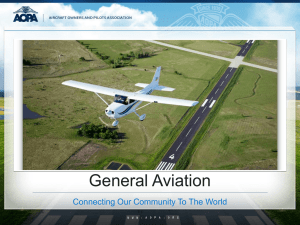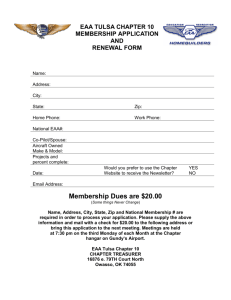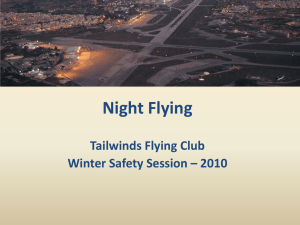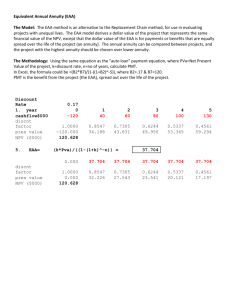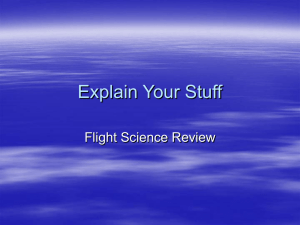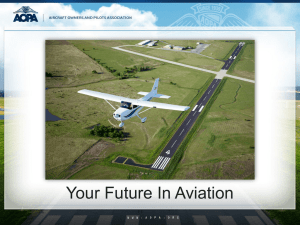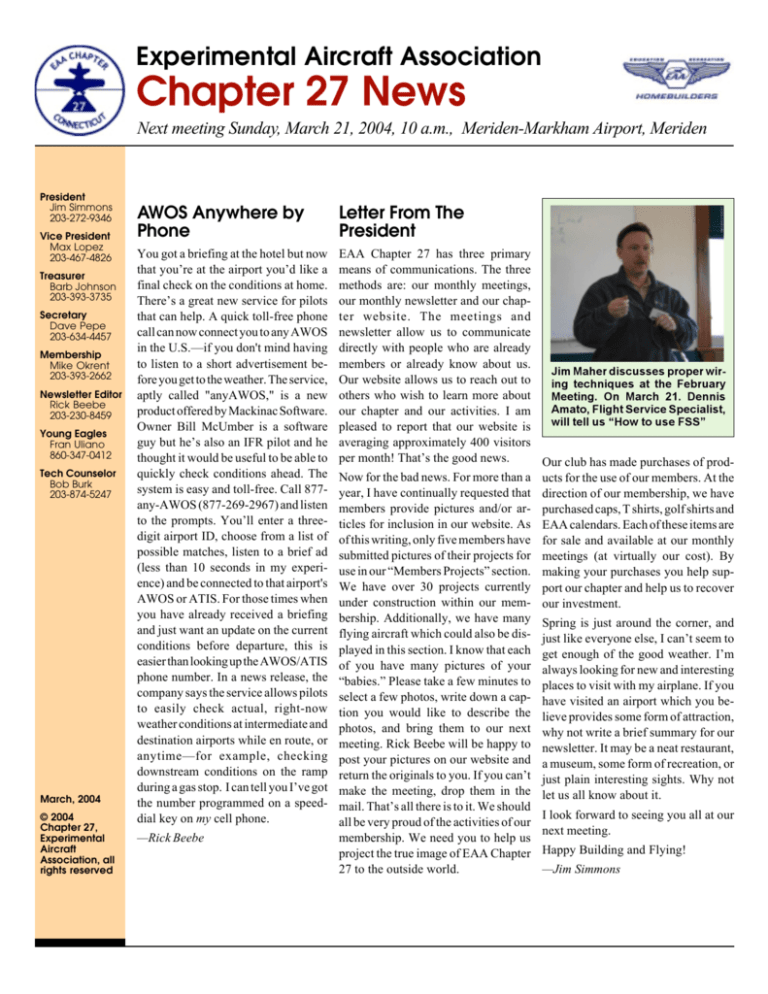
Experimental Aircraft Association
Chapter 27 News
Next meeting Sunday, March 21, 2004, 10 a.m., Meriden-Markham Airport, Meriden
President
Jim Simmons
203-272-9346
Vice President
Max Lopez
203-467-4826
Treasurer
Barb Johnson
203-393-3735
Secretary
Dave Pepe
203-634-4457
Membership
Mike Okrent
203-393-2662
Newsletter Editor
Rick Beebe
203-230-8459
Young Eagles
Fran Uliano
860-347-0412
Tech Counselor
Bob Burk
203-874-5247
March, 2004
© 2004
Chapter 27,
Experimental
Aircraft
Association, all
rights reserved
AWOS Anywhere by
Phone
Letter From The
President
You got a briefing at the hotel but now
that you’re at the airport you’d like a
final check on the conditions at home.
There’s a great new service for pilots
that can help. A quick toll-free phone
call can now connect you to any AWOS
in the U.S.—if you don't mind having
to listen to a short advertisement before you get to the weather. The service,
aptly called "anyAWOS," is a new
product offered by Mackinac Software.
Owner Bill McUmber is a software
guy but he’s also an IFR pilot and he
thought it would be useful to be able to
quickly check conditions ahead. The
system is easy and toll-free. Call 877any-AWOS (877-269-2967) and listen
to the prompts. You’ll enter a threedigit airport ID, choose from a list of
possible matches, listen to a brief ad
(less than 10 seconds in my experience) and be connected to that airport's
AWOS or ATIS. For those times when
you have already received a briefing
and just want an update on the current
conditions before departure, this is
easier than looking up the AWOS/ATIS
phone number. In a news release, the
company says the service allows pilots
to easily check actual, right-now
weather conditions at intermediate and
destination airports while en route, or
anytime—for example, checking
downstream conditions on the ramp
during a gas stop. I can tell you I’ve got
the number programmed on a speeddial key on my cell phone.
EAA Chapter 27 has three primary
means of communications. The three
methods are: our monthly meetings,
our monthly newsletter and our chapter website. The meetings and
newsletter allow us to communicate
directly with people who are already
members or already know about us.
Jim Maher discusses proper wirOur website allows us to reach out to
ing techniques at the February
others who wish to learn more about
Meeting. On March 21. Dennis
Amato, Flight Service Specialist,
our chapter and our activities. I am
will tell us How to use FSS
pleased to report that our website is
averaging approximately 400 visitors
per month! That’s the good news.
Our club has made purchases of prodNow for the bad news. For more than a ucts for the use of our members. At the
year, I have continually requested that direction of our membership, we have
members provide pictures and/or ar- purchased caps, T shirts, golf shirts and
ticles for inclusion in our website. As EAA calendars. Each of these items are
of this writing, only five members have for sale and available at our monthly
submitted pictures of their projects for meetings (at virtually our cost). By
use in our “Members Projects” section. making your purchases you help supWe have over 30 projects currently port our chapter and help us to recover
under construction within our mem- our investment.
bership. Additionally, we have many Spring is just around the corner, and
flying aircraft which could also be dis- just like everyone else, I can’t seem to
played in this section. I know that each get enough of the good weather. I’m
of you have many pictures of your always looking for new and interesting
“babies.” Please take a few minutes to places to visit with my airplane. If you
select a few photos, write down a cap- have visited an airport which you betion you would like to describe the lieve provides some form of attraction,
photos, and bring them to our next why not write a brief summary for our
meeting. Rick Beebe will be happy to newsletter. It may be a neat restaurant,
post your pictures on our website and a museum, some form of recreation, or
return the originals to you. If you can’t just plain interesting sights. Why not
make the meeting, drop them in the let us all know about it.
mail. That’s all there is to it. We should
I look forward to seeing you all at our
all be very proud of the activities of our
next meeting.
membership. We need you to help us
project the true image of EAA Chapter Happy Building and Flying!
—Rick Beebe
27 to the outside world.
—Jim Simmons
2 Chapter 27 News
Member Profile—Bill Jagoda
I graduated in 1975 from Worcester Polytechnic Institute with a Bachelors degree in Civil
Engineering. I’ve worked as a structural stress
analyst in the nuclear engineering department
at the Electric Boat Company in Groton for 26
years. I’ve been able to make some significant
(I think) contributions to the Trident, Seawolf
and Virginia submarine programs. I am currently working with our partners (Newport
News Shipbuilding) designing the reactor
compartments for what will eventually be the
CVN-78 aircraft carrier. This ship will replace the USS Enterprise (CVN-65) when it is
retired in 2014.
I got started flying with a 1988 Christmas gift
from a friend. It was a 30-minute introduction
flight at MMK in a C-152. I remember it being
very much like the Young Eagle flights we
give today—a preflight and a short local
flight—except I was in the left seat. I signed
up for ground school and passed my written in
May 1989. Unfortunately, just as I was about
to start flight training, the FBO at MMK
closed. I ended up taking my flight training at
Robertson Field. I soloed on 03/03/90 and
passed my check ride on 01/27/91.
I felt no great urge to fly larger airplanes or get
an instrument rating. However, I did like
cross-country flying and flew rental C-152s
all over the northeast. On 09/12/92 I got
checked out in a C-172 and have been flying
that type ever since. As my cross-country
flights became longer, the limitations of renting became apparent so I began to think
seriously about aircraft ownership. I purchased
N20634, a 1973 C-172 from a gentleman
from Virginia on 06/16/94. It is the airplane I
still own and fly today.
In 1998 I moved N20634 to
MMK. I joined Chapter 27 and
also began taking instrument
training. I passed my instrument check ride on 07/28/00.
It was in real instrument conditions. The examiner logged
1.6 hours of “actual instrument” time in my logbook. I
hadn’t been in solid IFR like
that during training—just some
in and out of the cloud stuff. As
we popped into the overcast, I
remember thinking “So, this is
how Kennedy killed himself.” Real cloud flying is different from flying with a hood or
foggles. I would encourage anyone who is
taking instrument training to try and get some
time in “actual” conditions with your instructor. It will make your task easier if the weather
on the day of your check ride is real IFR.
The instrument rating would come in handy
one day in September 2001. I had a crosscountry trip planned for Saturday September
15, 2001 to Concord, NH. As we all know, in
the weeks after September 11th, VFR general
aviation flights were not allowed. IFR flights
were OK. I decided to go, as the weather was
beautiful autumn CAVU. When I got my
weather briefing and filed my flight plan, the
FSS briefer cautioned me to make sure I was
absolutely familiar with the intercept procedures in the AIM and to be sure to monitor
121.5 during the flight as AWACS planes
were watching everyone and any intercepting
fighters might try and talk to me on 121.5. The
flight went off without a problem but the ATC
frequencies were eerily quiet. Other than airliners, there were few GA airplanes flying that
weekend.
Another memorable IFR flight took place on
July 7, 2002. I was returning home from Ohio
and stopped for fuel at the Connellsville, Pa
airport south of Pittsburgh. I had been flying
VFR but planned to file IFR for the next leg
since visibilities over the entire Northeast
were low due smoke from a forest fire in
Canada. As I walked to the FBO building, I
saw a white, gray and red RV-6A that looked
familiar. I walked over and looked at the
nameplate. It said “Builder: Mike Zemsta”. I
offered Mike and Patty a ride home and they
accepted (Austin was about minus 6 weeks
old at the time). Over central Pennsylvania at
5000 feet we lost sight of the ground - solid
IFR in smoke! However, we had an uneventful flight home to MMK.
Well, that’s my story. It’s been said that flying
is the last great adventure for modern man. I
agree. Since starting to fly, I’ve met a lot of
great people and had some great adventures.
That 1988 Christmas gift introductory flight
sure changed my life forever and for the better.
Congratulations Joe!
February Meeting Attendance
Contratulations to Joe Gauthier for receiving
FAA authorization to perform homebuilt aircraft inspections through the new
amateur-built designated airworthiness representative (AB-DAR) program.
Minutes were not submitted for the February
meeting. President Jim Simmons, Vice President Max Lopez and Treasurer Barb Johnson
were present. The following people signed the
roster: Robert Aiksnoras, George Anderson,
Rick Beebe, Ted Brainerd, Stanley Chaffin,
Fred Dube, Charlie Enz, Steve Fraas Joan
Howell, Bill Jagoda, Barb Johnson, Tim Kelly,
Chris Kohler, Maury Libson, Max Lopez, Jim
Maher, Ray Morgan, Chris O’Connor, Mike
Okrent, Bob Ryan, Rick Reavely, Jim
Simmons, Stan Solecki, Donald Turecek, Fran
Uliano, Bob Upson and visitors Alan Fitz,
Joanne Brainerd and Richard Merrill.
Experimental Aircraft Association 3
What’s an ADIZ?
Anyone flying into the Baltimore/Washington area now has to deal with the Washington
Air Defense Identification Zone or ADIZ.
There are strict rules and procedures to follow
and not complying could get you shot down.
To help avoid that, AOPA has prepared an
excellent online tutorial. It clearly defines all
of the procedures necessary to safely enter or
exit the ADIZ, whether you’re landing or just
passing through. The web site for this tutorial
is www.aopa.org/adiz and is available to
everyone. In addition to the tutorial, the site
also contains links to the relevant documentation for each airport within the ADIZ.
Sun-n-Fun Invitation
Carl Eaton, EAA Chapter 27 member and
resident of Okeechobee, Florida sends us a
reminder that Sun-N-Fun is just around the
corner: April 13 thru April 19. Information
about the event can easily be obtained at:
www.sun-n-fun.org. For those of you planning on flying your own aircraft, you can
order a copy of the NOTAM on the same
website.
Carl and his wife Lorainne are full time
volunteers at both Sun-N-Fun and
AirVenture. They look forward to seeing
you there.
APRIL 13 19, 2004
Help Fight Government Restrictions
EAA is encouraging its members to contact
their congressional representatives to express
their concern about a proposed amendment to
the Homeland Security Act of 2002 (HR 3798)
that would place additional restrictions on
general aviation beyond what has been deemed
prudent and effective by the Transportation
Security Administration and the Department
of Homeland Security.
Rep. Edward J. Markey (D-MA) proposed the
amendment titled “Secure Existing Aviation
Loopholes.” In addition to many restrictions
on commercial operation, the Bill proposes
that the Secretary of Homeland Security will
automatically establish no-fly zones over all
nuclear, chemical and “sensitive” facilities
any time the alert level gets to orange or at any
other time the Secretary determines appropriate. Next it requires GA airports to complete
and comply with “vulnerability assessments”
developed by Homeland Security.
General aviation organizations have been
working continuously with the TSA to develop GA airport security guidelines since the
September 11, 2001, terrorist attacks. “Let the
TSA and industry develop these guidelines
before imposing new restrictive federal laws
on an already heavily regulated industry,”
Lawrence said.
No Connecticut representatives are listed as
sponsoring the bill and we should let them
know how we feel about it. To find contact
information for your representative, visit
www.house.gov.
the airport, prohibiting all operations. The
size of the TFR was subsequently reduced so
that operations could resume, but the location
of the TFR caused cancellation of the only
instrument approach procedure into the airport.
The proposed prohibited area will have a 2
n.m. radius up to but not including 3,000'
MSL, centered on 30-degrees, 48-minutes
North, 81-degrees, 31-minutes West. The FAA
is accepting comments on the notice of proposed rulemaking (NPRM) until April 12,
2004.
"The FAA and, more importantly, the Department of Defense need to hear from the people
affected by this change—general aviation pilots," said Boyer. "AOPA urges pilots to file
"This is a general aviation pilot's worst night- formal comments."
mare and has questionable security benefits," Pilots may file comments online dms.dot.gov
said AOPA President Phil Boyer. "The Penta- by clicking on "Simple Search" and entering
gon is dictating national airspace policy. And docket number 15976.
it could get worse. AOPA has learned that the Written comments should be mailed to: Docket
DoD has already submitted requests to turn Management System, U.S. Department of
the remaining permanent TFRs into prohib- Transportation, Room Plaza 401, 400 Sevited areas."
enth St. SW, Washington D.C., 20590-0001.
Secondly, at the US Navy's insistence, the
FAA formally proposed turning the DoD TFR
over the Kings Bay Naval Base in Georgia
into prohibited airspace.
“The Transportation Security Administration
and the FAA have assessed, and continue to
do so, the security risks general aviation poses
and are taking the appropriate actions,” said
Earl Lawrence, EAA vice president of regulaThe existing TFR has severely impacted op- Make sure to include the full docket identifitory & industry affairs. “Mandated no-fly
erations at St. Marys Airport (4J6) in nearby cation (FAA-2003-15976/Airspace Docket
zones will not improve national security, nor
St. Marys, Ga. Originally, the TFR covered No. 03-AWA-5) at the beginning of written
will mandatory vulnerability assessments.”
comments.
4
at
A check ride
ought to be
like a skirt:
short enough
to be
interesting but
still be long
enough to
cover
everything.
Warwick
Aerodrome
(N72)
For Sale
Warwick, NY
I have an EAA Biplane/Lycoming 0-290-G4
that was meticulously constructed by my
father in 1970. It has always been hangared
and well cared for. It has not been flown for
some years now and my father has reluctantly decided to sell it. If youre interested,
call Edward Maziarz at (413)536-9839.
(editors note: photo is of a different EAA biplane)
sponsored by
Sunday,
May 16, 2004
10am to 4pm
No Rain Date
Food and Beverages Available
Trophies Awarded for Best Aircraft in Each Class
Registration for Judging Closes at 1:00 p.m.
EAA
Chapter 501
Call
973-838-7485 or
973-492-9025 for
more information
The deadline for submission of materials for the April newsletter is April 7, 2004.
2004 EAA CHAPTER 27 MEMBERSHIP FORM
Please fill in the following information and mail with your dues to:
EAA Chapter 27, c/o Barbara Johnson, 9 Dillon Rd., Woodbridge, CT 06525
(Dues are $15.00 per year, make checks payable to: EAA Chapter 27)
Name: ________________________________________ Phone: ____________________________________
Street: ___________________________________________________________________________________
It is possible to
fly without
motors, but not
without
knowledge
and skill.
—Wilbur Wright
City __________________________________________ State ________________ Zip _________________
Email address: ____________________________________________________________________________
EAA Membership No: ___________________________ Pilot rating held: ____________________________
Do you own an aircraft?: ___________ Make & Model: _________________ Registration No: ___________
Are you building an aircraft?: _______ Make & Model: _________________ % completed? _____________
EAA Chapter 27
c/o Richard Beebe II
360 Mountain Rd
Hamden, CT 06514-1415
newsletter@eaa27.org
Meetings held on the third Sunday of the month at Meriden-Markham Airport,
Meriden, CT at 10am unless otherwise noted.
www.eaa27.org

